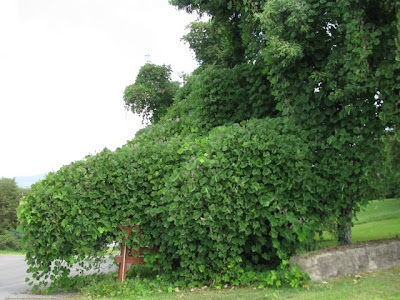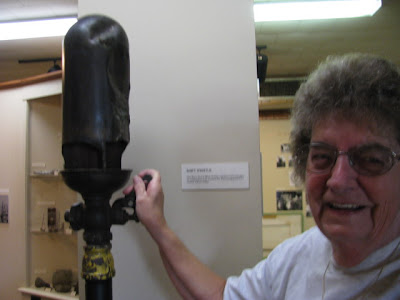Welcome to Ducktown, a "quacking good place." The sign is misleading however. The name Ducktown actually has nothing to do with ducks, but everything to do with the Cherokee Indians who were the first to inhabit the area. The settlement was named after their leader, Chief Duck.
 Or, as Carol likes to tell the story, people in this town were always feuding, and during one of the more violent feuds, somebody yelled "Duck down!" The population of Ducktown at the 2000 census was 427, comprised of 209 households, more than 25% below the poverty level. One of the highlights of a tour of the town is Kimsey Junior College:
Or, as Carol likes to tell the story, people in this town were always feuding, and during one of the more violent feuds, somebody yelled "Duck down!" The population of Ducktown at the 2000 census was 427, comprised of 209 households, more than 25% below the poverty level. One of the highlights of a tour of the town is Kimsey Junior College: Just kidding...that's their pumping station. Here's the real Kimsey Junior College: "The only architect-designed structure in Tennessee's Copper Basin and a rare rural example of Collegiate Gothic Architecture, Kimsey Junior College, designed by architect Reuben H. Hunt, was built in 1932-33 for a state college, but was never used for its intended purpose, and became a vocational and general school for Ducktown. Though now vacant and beginning to suffer from deterioration, the City of Ducktown has shown an interest in acquiring the property for a community center. It is on the U.S. National Register of Historic Places. It was named for Dr.L.E. Kimsey who had practiced medicine in Ducktown for approximately 50 years and was well known throughout that section of the country. When he began his practice, he used to make trips to patients on horseback and afoot."
Just kidding...that's their pumping station. Here's the real Kimsey Junior College: "The only architect-designed structure in Tennessee's Copper Basin and a rare rural example of Collegiate Gothic Architecture, Kimsey Junior College, designed by architect Reuben H. Hunt, was built in 1932-33 for a state college, but was never used for its intended purpose, and became a vocational and general school for Ducktown. Though now vacant and beginning to suffer from deterioration, the City of Ducktown has shown an interest in acquiring the property for a community center. It is on the U.S. National Register of Historic Places. It was named for Dr.L.E. Kimsey who had practiced medicine in Ducktown for approximately 50 years and was well known throughout that section of the country. When he began his practice, he used to make trips to patients on horseback and afoot."But seriously, Ducktown and the surrounding area is most famous for its copper, AKA the Copper Basin. Although, the Cherokee used the local copper to make ornaments, full-time copper mining began after a prospector discovered the rich copper ore in nearby Potato Creek while looking for gold in 1843. The Burra Burra Mine was the first of a series of mining operations that occurred throughout the Copper Basin from 1850-1987.
 A view of Ducktown from the parking lot of the old Burra Burra Mining Operation.
A view of Ducktown from the parking lot of the old Burra Burra Mining Operation.



 Picture this: From the edge of the parking lot you look down upon a desert-like area of red earth that extends for miles around. It reminds you of the Dakota Badlands, but this is Tennessee's Copper Basin, and the vista is man-made. The creation of this surreal landscape is due to a combination of timber stripping, erosion, sulphur dioxide fumes, and subterranean blasting.
Picture this: From the edge of the parking lot you look down upon a desert-like area of red earth that extends for miles around. It reminds you of the Dakota Badlands, but this is Tennessee's Copper Basin, and the vista is man-made. The creation of this surreal landscape is due to a combination of timber stripping, erosion, sulphur dioxide fumes, and subterranean blasting.
 A view of Ducktown from the parking lot of the old Burra Burra Mining Operation.
A view of Ducktown from the parking lot of the old Burra Burra Mining Operation.
The mine manager's house.

A couple of the old mining buildings:

The Powder House: where the dynamite was stored.
 Picture this: From the edge of the parking lot you look down upon a desert-like area of red earth that extends for miles around. It reminds you of the Dakota Badlands, but this is Tennessee's Copper Basin, and the vista is man-made. The creation of this surreal landscape is due to a combination of timber stripping, erosion, sulphur dioxide fumes, and subterranean blasting.
Picture this: From the edge of the parking lot you look down upon a desert-like area of red earth that extends for miles around. It reminds you of the Dakota Badlands, but this is Tennessee's Copper Basin, and the vista is man-made. The creation of this surreal landscape is due to a combination of timber stripping, erosion, sulphur dioxide fumes, and subterranean blasting. Cleanup and restoration is still being done. The Forest Service has planted trees to try to restore the land to the way it once looked. Carol's well water still smells and tastes like sulfur. If you visit Carol, bring your own water.
Cleanup and restoration is still being done. The Forest Service has planted trees to try to restore the land to the way it once looked. Carol's well water still smells and tastes like sulfur. If you visit Carol, bring your own water. In the foreground of this landscape, far below you, is a chasm filled by a deep green lake. The lake was created when the mine tunnels collapsed, some more than 3,000 feet below the surface.
In the foreground of this landscape, far below you, is a chasm filled by a deep green lake. The lake was created when the mine tunnels collapsed, some more than 3,000 feet below the surface. 
The lake is said to be 4,100 feet deep.
You can follow this coppery trail to see some of the old equipment.

A diesel engine pulled this train through the mine tunnels.

Where the engineer sat.

Metal plate still affixed to the engine.

End of our trail.
All that's left of that structure.
Smelting pot

Pieces of a burra pump...one of a series used at different levels to help keep the workings dry. About 200 gallons of water a minute had to be pumped to the surface from underground.

These pulleys were used to hoist workers up and down into the mine by elevator.

The Hoist House where the big wheels were housed, and Boiler Building.

Fragrant Kudzu blooms
 Kudzu vines were introduced to this area to help cover the bare hills. That caused a secondary environmental disaster as it is an invasive species that now covers everything and is killing native trees.
Kudzu vines were introduced to this area to help cover the bare hills. That caused a secondary environmental disaster as it is an invasive species that now covers everything and is killing native trees.
The Museum once housed the mine manager's offices.
 The town of Isabella, one of the communities set up by the mining companies for their employees.
The town of Isabella, one of the communities set up by the mining companies for their employees.
Some history about the workers.

The mine telephone.

A simulated mine tunnel you can walk through & get a feel of what it was like.

A photo from the mines.

A poem written when the mine closed in 1987.
 The Burra Burra Mine Whistle signaled shift changes for employees and marked the day's progression for nearby communities. I dared Carol to try it.
The Burra Burra Mine Whistle signaled shift changes for employees and marked the day's progression for nearby communities. I dared Carol to try it.
Never dare Carol to do anything.









SO glad you're back to blogging. Are these places interesting or does your interest make them so? Thanks for your wonderful photos and narrations.
ReplyDeleteGreat trip. Love the Carol pix.
ReplyDelete